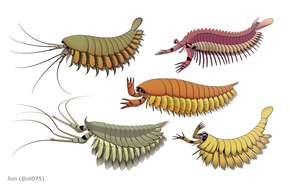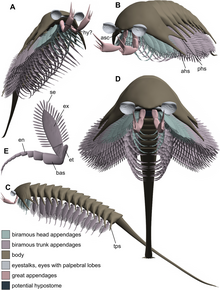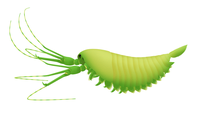Megacheira
| Megacheira Temporal range:Possible Silurian and Devonian records
| |
|---|---|

| |
| Alalcomenaeus(top left),Fortiforceps(top right),Haikoucaris(middle),Leanchoilia(bottom left) andYohoia(bottom right). | |
| Scientific classification | |
| Domain: | Eukaryota |
| Kingdom: | Animalia |
| Phylum: | Arthropoda |
| Class: | †Megacheira Houand Bergström, 1997 |
| Groups | |
|
See text | |
Megacheira( "great hands", also historicallygreat appendage arthropods) is an extinct class of predatoryarthropodsdefined by their possession of spined "great appendages".[1]Their taxonomic position is controversial, with studies either considering themstem-groupeuarthropods, or stem-groupchelicerates.[2][3]Thehomologyof the great appendages to the cephalic appendages of other arthropods is also controversial. Uncontested members of the group were present in marine environments worldwide from the lower to middleCambrian.
Morphology
[edit]
Megacheirans are defined by their possession ofuniramous"great appendages", which are their first pair of head appendages. The first one or two proximalmost segments/podomeresare spineless (it has been argued that the supposed first of the two proximal podomeres is actually an arthrodial membrane[4]), while the remaining 3–4 more distal podomeres each typically bore a single upward pointing spine attached towards thedistalend of the segment, with the spineless proximal segment/s typically being connected to the spined distal segments by an elbow-like joint, which curled upwards.[5][4]The great appendages have been interpreted asraptoriallimbs involved in predation, with those of some genera such asYohoiabeing structurally comparable to the raptorial maxillipeds ofmantis shrimp.[5]The spines on the great appendages of leanchoilid megacheirans such asLeanchoiliaandYawunikare elongated into flagella-like structures, suggesting a sensory role alongside predatory function.[6]The body is divided into the head and the trunk. Thebiramouslimbs of megacheirans are homonomous (i.e. having little differentiation from each other), withendopodstypically divided into seven segments/podomeres, and paddle-shapedexopods,which are fringed with thin lamellae. The morphology of the terminaltelsonsegment is variable.[4]The biramous limbs of at least some megacheirans have been suggested to have borneexites.[7]
Taxonomy
[edit]Several subdivisions within the group are recognised including Jianfengiidae (includingFortiforceps,Jianfengia,Sklerolibyonand possiblyParapeytoia) which are known from the Early Cambrian of China, as well as the Cheiromorpha (containing at leastYohoia,Haikoucaris,and Leanchoiliidae), known with certainty from the Early-Mid Cambrian of North America, China and Australia, which is distinguished from Jianfengiidae by having a fewer number of body segments (20+ in Jianfengiidae, as compared to typically only 11 to 13 in Cheiromorpha). Themonophylyof Megacheira is uncertain, with some studies recovering the group asparaphyletic.[4]
Parapeytoia,which formerly misinterpreted as aradiodontwas later suggested to be a member of this group.[8][9][10]Possible megacheirans includeEnalikterdescribed from theSilurianof theUnited Kingdom,andBundenbachiellusfrom the EarlyDevonianofGermany;[11][12]due to their possession of great appendage-like cephalic appendages. However, their relationship to megacheirans has been questioned, due to the uncertainhomologyof their appendages.[13]Kootenichelahas been suggested to be achimeraof various arthropod taxa.[4]Previous inclusion of some "bivalved" genera such asForfexicaris,Ovalicephalus,andOccacaristo Megacheira was questioned by later investigations.[14]The Late CambrianOrstentaxonOelandocaristypically considered to be a crustacean relative, has also been suggested in some studies to be a megacheiran.[15]
-
Life reconstruction ofFortiforceps(left) andSklerolibyon(right)
-
Life restoration ofJianfengia
-
Closeup of great appendages ofLeanchoiliasuperlata
-
Life restoration ofYawunik
List of genera
[edit]- †Tanglangia
- †Oelandocaris?
- †Jianfengiidae
- †Kootenichelidae?
- †Cheiromorpha
- Yohoia
- Haikoucaris
- Leanchoiliida
- Enaliktidae?
- Leanchoiliidae
Relationship to other arthropods
[edit]Megacheirans are either suggested to be stem-groupcheliceratesor stem-group arthropods,[2]with the former hypothesis based on thechelicerae-like morphology of the great appendages[16][17][18]alongside neuroanatomy[19]and the presence of a reducedlabrum[20]resembling those of modern chelicerates, it being argued that chelicerae and the great appendages are homologous structures.[21]Other studies suggest that the megacheirans are stem-group arthropods based on the argument that the great appendages are homologous to the frontal appendages of stem-group arthropods likeIsoxysandradiodonts.This identity is disputed, with other authors suggesting that the frontal appendages of radiodonts are homologous to the labrum of modern arthropods.[4]
References
[edit]- ^Stein, Martin (March 2010) [26 February 2010]. "A new arthropod from the Early Cambrian of North Greenland, with a 'great appendage'-like antennula".Zoological Journal of the Linnean Society.158(3): 477–500.doi:10.1111/j.1096-3642.2009.00562.x.
- ^abAria, Cédric (26 April 2022)."The origin and early evolution of arthropods".Biological Reviews.97(5): 1786–1809.doi:10.1111/brv.12864.ISSN1464-7931.PMID35475316.S2CID243269510.Archivedfrom the original on 8 May 2024.Retrieved8 May2024.
- ^Liu, Cong; Fu, Dongjing; Wu, Yu; Zhang, Xingliang (July 2024)."Cambrian euarthropod Urokodia aequalis sheds light on the origin of Artiopoda body plan".iScience.27(8): 110443.doi:10.1016/j.isci.2024.110443.PMC11325232.PMID39148713.
- ^abcdefAria, Cédric; Zhao, Fangchen; Zeng, Han; Guo, Jin; Zhu, Maoyan (December 2020)."Fossils from South China redefine the ancestral euarthropod body plan".BMC Evolutionary Biology.20(1): 4.doi:10.1186/s12862-019-1560-7.ISSN1471-2148.PMC6950928.PMID31914921.
- ^abHaug, Joachim T.; Waloszek, Dieter; Maas, Andreas; Liu, Yu; Haug, Carolin (March 2012)."Functional morphology, ontogeny and evolution of mantis shrimp-like predators in the Cambrian: MANTIS SHRIMP-LIKE CAMBRIAN PREDATORS".Palaeontology.55(2): 369–399.doi:10.1111/j.1475-4983.2011.01124.x.
- ^Aria, Cédric; Caron, Jean-Bernard; Gaines, Robert (2015)."A large new leanchoiliid from the Burgess Shale and the influence of inapplicable states on stem arthropod phylogeny".Palaeontology.58(4): 629–660.doi:10.1111/pala.12161.S2CID86443516.
- ^Liu, Yu; Edgecombe, Gregory D.; Schmidt, Michel; Bond, Andrew D.; Melzer, Roland R.; Zhai, Dayou; Mai, Huijuan; Zhang, Maoyin; Hou, Xianguang (30 July 2021)."Exites in Cambrian arthropods and homology of arthropod limb branches".Nature Communications.12(1): 4619.doi:10.1038/s41467-021-24918-8.ISSN2041-1723.PMC8324779.PMID34330912.
- ^Stein, Martin (1 March 2010)."A new arthropod from the Early Cambrian of North Greenland, with a 'great appendage'-like antennula".Zoological Journal of the Linnean Society.158(3): 477–500.doi:10.1111/j.1096-3642.2009.00562.x.ISSN0024-4082.Archivedfrom the original on 3 November 2019.Retrieved29 October2019.
- ^Xian-Guang, Hou; Siveter, David J.; Siveter, Derek J.; Aldridge, Richard J.; Pei-Yun, Cong; Gabbott, Sarah E.; Xiao-Ya, Ma; Purnell, Mark A.; Williams, Mark (24 April 2017).The Cambrian Fossils of Chengjiang, China: The Flowering of Early Animal Life.John Wiley & Sons.ISBN9781118896389.Archivedfrom the original on 8 May 2024.Retrieved10 May2021.
- ^Daley, Allison C.; Budd, Graham E.; Caron, Jean-Bernard; Edgecombe, Gregory D.; Collins, Desmond (20 March 2009). "The Burgess Shale Anomalocaridid Hurdia and Its Significance for Early Euarthropod Evolution".Science.323(5921): 1597–1600.doi:10.1126/science.1169514.ISSN0036-8075.PMID19299617.S2CID206517995.
- ^Siveter, Derek J.; Briggs, Derek E. G.; Siveter, David J.; Sutton, Mark D.; Legg, David; Joomun, Sarah (7 March 2014)."A Silurian short-great-appendage arthropod".Proceedings of the Royal Society B.281(1778): 20132986.doi:10.1098/rspb.2013.2986.PMC3906945.PMID24452026.
- ^Derek J. Siveter; Derek E. G. Briggs; David J. Siveter; Mark D. Sutton; David Legg; Sarah Joomun (2015)."Enalikter aphsonis an arthropod: a reply to Strucket al.(2014) ".Proceedings of the Royal Society B.282(1804): 20142663.doi:10.1098/rspb.2014.2663.PMC4375861.
- ^Aria, Cédric (October 2022)."The origin and early evolution of arthropods".Biological Reviews.97(5): 1786–1809.doi:10.1111/brv.12864.ISSN1464-7931.PMID35475316.S2CID243269510.Archivedfrom the original on 8 May 2024.Retrieved8 May2024.
- ^Ortega-Hernández, Javier; Janssen, Ralf; Budd, Graham E. (1 May 2017)."Origin and evolution of the panarthropod head – A palaeobiological and developmental perspective".Arthropod Structure & Development.Evolution of Segmentation.46(3): 354–379.doi:10.1016/j.asd.2016.10.011.ISSN1467-8039.PMID27989966.
- ^Aria, Cédric; Caron, Jean-Bernard (May 2017)."Burgess Shale fossils illustrate the origin of the mandibulate body plan".Nature.545(7652): 89–92.doi:10.1038/nature22080.ISSN0028-0836.PMID28445464.S2CID4454526.Archivedfrom the original on 23 September 2022.Retrieved12 January2023.
- ^Chen, Junyuan; Waloszek, Dieter; Maas, Andreas (2004). "A new 'great-appendage' arthropod from the Lower Cambrian of China and homology of chelicerate chelicerae and raptorial antero-ventral appendages".Lethaia.37(1): 3–20.doi:10.1080/00241160410004764.ISSN1502-3931.
- ^Chen, Jun-Yuan (2009)."The sudden appearance of diverse animal body plansduring the Cambrian explosion".The International Journal of Developmental Biology.53(5–6): 733–751.doi:10.1387/ijdb.072513cj.ISSN1696-3547.PMID19557680.
- ^Haug, Joachim T.; Waloszek, Dieter; Maas, Andreas; Liu, Yu; Haug, Carolin (March 2012)."Functional morphology, ontogeny and evolution of mantis shrimp-like predators in the Cambrian: MANTIS SHRIMP-LIKE CAMBRIAN PREDATORS".Palaeontology.55(2): 369–399.doi:10.1111/j.1475-4983.2011.01124.x.S2CID82841481.
- ^Tanaka, Gengo; Hou, Xianguang; Ma, Xiaoya; Edgecombe, Gregory D.; Strausfeld, Nicholas J. (17 October 2013). "Chelicerate neural ground pattern in a Cambrian great appendage arthropod".Nature.502(7471): 364–367.doi:10.1038/nature12520.PMID24132294.S2CID4456458.
- ^Liu, Yu; Ortega-Hernández, Javier; Zhai, Dayou; Hou, Xianguang (25 June 2020)."A Reduced Labrum in a Cambrian Great-Appendage Euarthropod".Current Biology.30(15): 3057–3061.e2.doi:10.1016/j.cub.2020.05.085.ISSN0960-9822.PMID32589912.S2CID220057956.
- ^Tanaka, Gengo; Hou, Xianguang; Ma, Xiaoya; Edgecombe, Gregory D.; Strausfeld, Nicholas J. (17 October 2013)."Chelicerate neural ground pattern in a Cambrian great appendage arthropod".Nature.502(7471): 364–367.doi:10.1038/nature12520.ISSN0028-0836.PMID24132294.S2CID4456458.Archivedfrom the original on 16 October 2022.Retrieved12 January2023.







